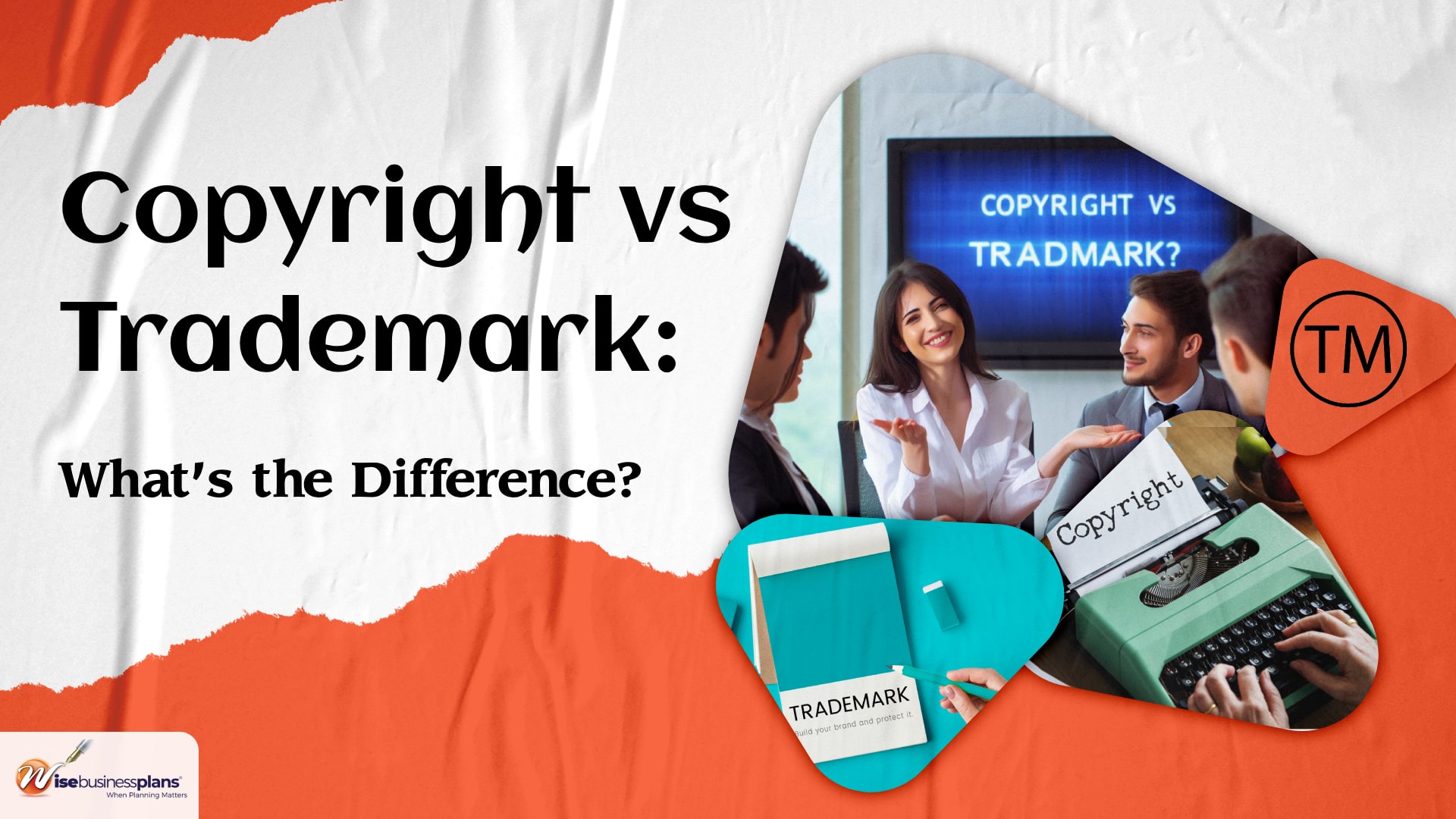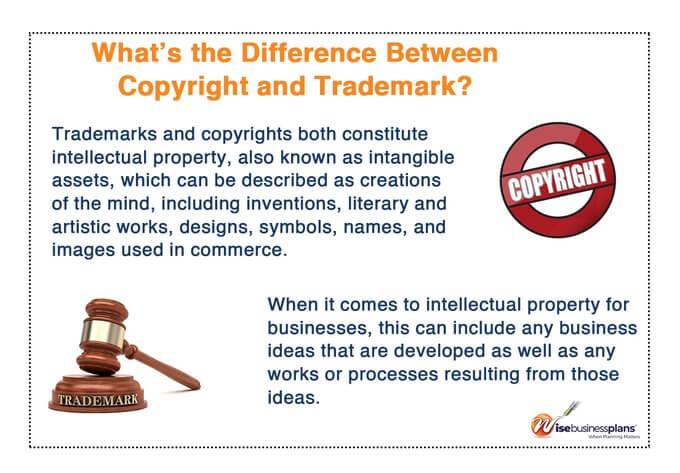Copyright vs. Trademark: What’s the Difference?
Table of Contents
Both copyrights and trademarks are important tools for protecting your intellectual property, but figuring out which one you need can be confusing.
Understanding intellectual property can be difficult, but doing so correctly can mean the difference between fighting a vicious court battle to protect your legal interests and quietly enjoying the fruits of your creative labors.
By protecting your business with copyrights and trademarks, you are able to take legal action against people who misuse your intellectual property and brand. In this guide, we’ll explain the difference between copyright and trademark so that you know which might apply to your business and, therefore, how to protect your intellectual property.
What’s the Difference Between Copyright and Trademark?
Trademarks and copyrights both constitute intellectual property, also known as intangible assets, which can be described as creations of the mind, including inventions, literary and artistic works, designs, symbols, names, and images used in commerce.
When it comes to intellectual property for businesses, this can include any business ideas that are developed as well as any works or processes resulting from those ideas. As a result, in the U.S., trademarks, and copyrights are used to safeguard intellectual property as well as patents.
As such, the key difference between copyright and trademark is that, although both offer intellectual property protection, they cover different types of assets and require different registration requirements.
Overall, copyright protects literary and artistic materials and works, including books and videos. It is automatically created during the creation of the work. On the other hand, a trademark protects items that identify the brand of a company, such as a business logo or slogan, and requires more extensive registration through the government to receive maximum legal protection.
Let’s break down each of these protections individually to better understand the differences.
What Does a Copyright Protect?
A copyright is a form of intellectual property protection that applies to original works and that is automatically generated by the creation of those works.
A copyright protects literary, dramatic, musical, and artistic works. These include:
- Poetry
- Novels
- Other forms of original writing
- Art
- Research
- Movies
- Songs
- Other forms of audio and video materials
- Computer software
- Architecture
When a work is created, it is protected under copyright as long as it is preserved in some form. On the other hand, works that cannot be copyrighted are those that are not available in a tangible form, for example, a speech that is not written down or recorded.
The following works cannot be protected by copyright:
- Ideas
- Discoveries
- Principles
- Listings of ingredients or contents (although a recipe or instructions can be copyrighted)
- Works that are considered “common property,” such as calendars or height and weight charts.
How to Protect a Copyright?
We briefly discussed above that besides the protection that copyright and trademarks provide, another distinction between the two is how they are protected.
Again, as we have discussed, copyright is generated automatically when a work is created. However, there are many precautions you can take to ensure that potential copyright infringers don’t use your work without permission.
Here are some examples:
- Properly marking: Make sure your work is properly marked, such as by signing or using a watermark, and that it has a clear evolutionary footprint from your work to your business.
- Poor man’s copyright: This method entails mailing your own work to yourself, which establishes the material as having been in one’s possession for an extended period of time. However, copyright law does not provide for this type of protection, and a poor man’s copyright is not a substitute for registering.
- Creative Commons: Creative Commons offers free copyright licenses that allow you to mark your creative work with the rights you want it to hold.
- Use the copyright symbol: At a bare minimum, you can use the © symbol to denote a copyrighted work.
In addition, although not required, you may decide to register your business with the U.S. Copyright Office. As a result, you will need to complete the application process-which includes paying a fee and sending a copy of the work-in order to officially register your copyright.
What Does a Trademark Protect?
A trademark, on the other hand, is a form of intellectual property protection that protects words, phrases, symbols, or designs that are unique to a particular brand (or source of goods).
Therefore, trademarks protect items such as:
- Brand names
- Logos
- Business names
- Slogans
A trademark can be applied to anything that essentially brands a business or identifies a product or company. Here are some examples that are well-known:
- Tabasco bottles with hexagonal screw tops are trademarked.
- The word “footlong,” as a whole, is a trademark of Subway sandwiches.
- There is a trademark on the Golden Arch of McDonald’s.
As a result, it is important to distinguish between a trademark and a service mark when it comes to trademarks. The term “trademark” typically encompasses both trademarks and service marks, but a service mark is used to distinguish the services offered by one business from those offered by another.
Having said all of this, another important difference between copyright and trademark is that whereas copyrights expire after a set amount of time, trademarks do not.
As a general rule, trademark rights arise from actual use-in other words, using the mark in the course of doing business so your trademark can last forever, as long as you use it.
Meanwhile, official trademark registration provides the same level of protection under the law as copyright registration. If you file specific documents and pay the necessary fees, your trademark registration can also last forever.
How to Protect a Trademark?
The registration of a trademark is not necessary, but it is certainly one of the best ways to protect your logo, brand name, or slogan.
In order to ensure that your branding materials are not already in use, you’ll want to conduct a trademark search. Additionally, you might choose to work with a trademark lawyer to help you register your trademark, although you can also submit an online application yourself through the U.S Patent and Trademark Office (USPTO) website.
To illustrate, if you wish to trademark your business name, you would first check with your state trademark office to make sure the name has not already been registered, and then complete the registration process. It’s important to note here that there’s a difference between state and federal trademark registration, with the latter providing the greatest level of protection.
Further, when it comes to business names specifically, you can register your business name with your state or county clerk by filing a DBA, though that is not the same as trademarking your business name.
Once you register your trademark with the USPTO, you’ll be able to use the registered trademark symbol “®” to indicate that your property is legally protected.
FAQs:
Copyright protection is a form of intellectual property protection that grants exclusive rights to the creators of original works, such as literary, artistic, or musical creations. It safeguards against unauthorized copying, distribution, or use of the work without permission.
A trademark is a symbol, word, phrase, or design that identifies and distinguishes the source of goods or services. It helps consumers recognize and differentiate products or services of one company from those of others. Trademarks can include logos, brand names, slogans, or even unique packaging.
Copyright protects original works of authorship, including literary works (books, articles), artistic works (paintings, sculptures), musical compositions, films, photographs, and other creative expressions. It provides exclusive rights to the copyright holder to reproduce, distribute, display, perform, or modify the work.
A trademark protects brand names, logos, slogans, and other distinctive elements that identify and distinguish products or services in the marketplace. It safeguards against unauthorized use of similar marks that could confuse consumers and dilute the brand’s reputation.
Copyright protection generally lasts for the lifetime of the creator plus an additional period after their death. In many countries, it extends for 70 years or more. Trademarks, on the other hand, can potentially last indefinitely as long as they are actively used and renewed according to the laws of the respective jurisdiction.

















